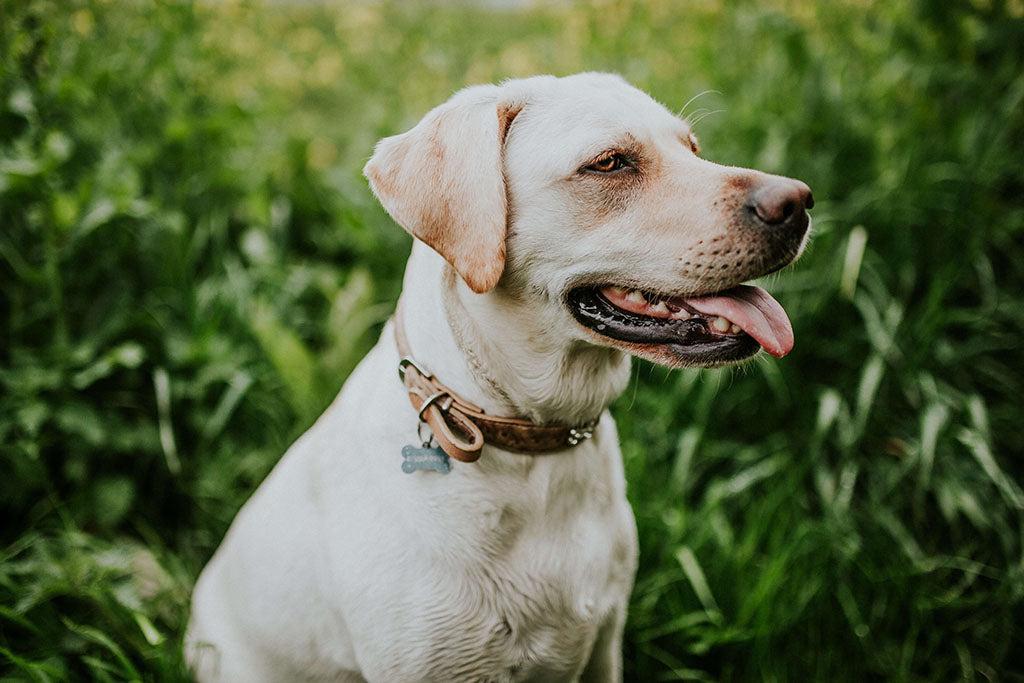Summary: In this blog, we learn how a dog collar and harness should fit so you can make sure your dog is comfortable and safe in their essential kit whilst out and about… A collar and a harness are not only there to carry your pup’s important identification tags (which are a legal requirement […]
How To Fit A Dog Collar And Harness

Summary: In this blog, we learn how a dog collar and harness should fit so you can make sure your dog is comfortable and safe in their essential kit whilst out and about…
A collar and a harness are not only there to carry your pup’s important identification tags (which are a legal requirement in some countries), but are also designed to help you keep control of your dog and make walking and exercising a comfortable, safe, and enjoyable experience for you both which is why the way they fit is an essential thing to consider…
How Should A Dog Collar Fit?
For the perfect fit dog collar, you’ll first need to measure your pup’s neck with a cloth measuring tape. Then, add two inches to this figure. This will be the size of collar you’ll need to purchase.
If you have a toy breed, you’ll only need to add one inch to this figure. If you have a very large breed like a Great Dane or Bernese Mountain Dog, you’ll need to add three.
When the collar is on your dog, it should feel snug but not tight. Both too loose and too tight a fit is dangerous for your pooch. You should be able to fit two fingers under your dog’s collar whilst it’s fastened on their neck. If you have a small dog or a teacup breed like a Chihuahua, this can just be one finger, and three on much larger dogs.
As a general rule, the larger the dog, the thicker the width of the collar should be as on larger breeds this will help reduce pressure on their necks.
If you’re fitting a collar on a puppy, you should purchase an adjustable collar that you can keep changing the size of as they grow. You should check their collar every couple of weeks until they get to adulthood as their neck can grow quite quickly.
If your dog gains or loses weight, this will affect their neck size and thus the comfort and safety of their collar. Regularly checking your dog’s collar is good practice as a responsible pet parent to make sure the fit is always just right.

How To Fit A Dog Harness
The most important thing when it comes to a perfect fit dog harness is purchasing the right size. You need to measure the thickest part of your pooch’s neck, the widest part of their rib cage, and know your dog’s current weight. Then, you can purchase according to these figures.
The way a harness fits is really important too; if it’s too tight it can lead to discomfort when moving and even cause sores. If it’s too loose, it can cause injuries if they pull on their leash.
A harness should fit tightly, but not too snug once adjusted – just like their collar. You should be able to fit two fingers under the harness at any point of their body, under any strap but not to the point they can slip out of it.
It’s also worth considering the material the harness is made from; nylon tubing or strapping is usually suitable for all breeds and sizes, but a mesh harness typically suits smaller breeds.
Not every harness will suit every dog, so be prepared for some trial and error when it comes to finding the perfect fit dog harness for your dog.

Dog Harness Vs Collar
Some dogs pull on their leashes, and a body harness can help discourage pulling as they help prevent doggos moving as far forward when they pull. Harnesses also help give you more control, particularly in busy areas like cities and in crowds, but also over larger breeds as it takes less of a toll on your arm and back strength. Harnesses are also considered safer, as they disperse pressure over a larger area of your pooch’s body, which reduces the amount of strain exerted on their neck.
With puppies, a harness can also prevent them from getting tangled up in their leash as they learn to be on one! It’s definitely something to research and explore with your dog.
It’s important to take time to introduce your dog to a harness though. Try to make this a really positive experience; treat and make a fuss of them while they’re wearing the harness the first few times. However, be patient. Some dogs may simply never learn to like to wear a harness – and for some, no amount of treats will be able to encourage them – and it’s not fair to force a dog to wear something they really hate.
If your dog is happy in a collar, do not be tempted by choke or prong collars that are designed to constrict or cause discomfort as a means of training. These are cruel, painful, and just cause a dog to be scared of them and you. They do not induce good behavior.
A dog can wear a harness and a collar at the same time, but a dog shouldn’t wear a harness full time as this may cause pinching and/or injury.
Sources
“How To Fit A Dog Collar Properly” Skinners, Jan 26. 2016 https://www.skinners.co.uk/news/how-to-fit-a-dog-collar-properly/
Author Davies, Ken “How Should A Dog Harness Fit? Avoiding The Dangers Of A Poor Fit” Pet Lover Guy, https://petloverguy.com/how-should-a-dog-harness-fit/
 S
S



